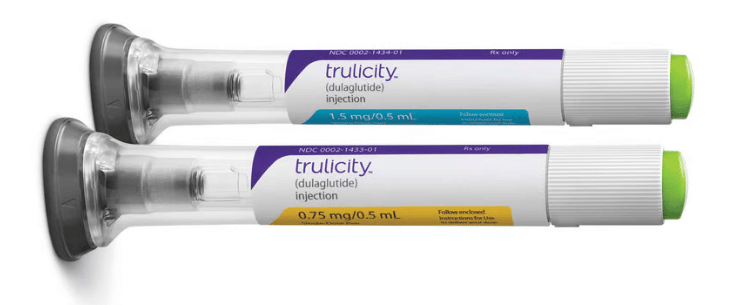**Trulicity vs Ozempic: A Comparison**
Excessive sugar in the blood, a condition known as type 2 diabetes, is increasingly common. Managing this condition typically involves a combination of exercise, a balanced diet, and often, medication prescribed by your healthcare provider to help control blood sugar levels.
Trulicity (dulaglutide) and Ozempic (semaglutide) are two injectable medications used in the treatment of type 2 diabetes. Both work similarly in managing the condition, but what sets them apart? Is one more effective than the other? Read on to discover the key differences between Trulicity and Ozempic.
## **What Is Trulicity?**
Trulicity, developed by Eli Lilly and Company, is designed to treat type 2 diabetes. It contains the active ingredient dulaglutide and is generally administered once a week to adults.
[Trulicity](https://prohealthsupporter.com/shop/trulicity-0-75mg-0-5ml/) is not intended to treat diabetic ketoacidosis or type 1 diabetes. However, when used as directed, it can help reduce the risk of various complications associated with type 2 diabetes, such as heart attacks, strokes, kidney failure, nerve damage, eye issues, and gum disease.
## **What Is Ozempic?**
Similar to [Trulicity](https://prohealthsupporter.com/shop/trulicity-1-5mg-0-5ml/), [Ozempic](https://prohealthsupporter.com/prescription-drugs/ozempic/) is also an injectable treatment for type 2 diabetes, typically administered once a week. It aids in weight loss by slowing the rate at which the stomach empties its contents.
Ozempic, produced by Novo Nordisk, contains the active ingredient semaglutide and has FDA approval for use in chronic weight management as well. It helps regulate blood sugar by stimulating the pancreas to release the appropriate amount of insulin when blood sugar levels are high.
## **Difference Between Trulicity and Ozempic**
Both [Ozempic](https://prohealthsupporter.com/prescription-drugs/ozempic/) and Trulicity should be used alongside a comprehensive diet and exercise plan. They are not intended as quick fixes for type 2 diabetes or as simple weight loss solutions.
These medications can also help reduce the risk of stroke, heart attack, or death in patients with type 2 diabetes who have existing heart and vascular conditions.
Trulicity is strictly approved for use in individuals with type 2 diabetes. Conversely, [Ozempic](https://prohealthsupporter.com/prescription-drugs/ozempic/) can be prescribed to patients with a Body Mass Index (BMI) of 30 or higher. It is also suitable for those with a BMI of 27 or more, provided they have additional metabolic health issues such as type 2 diabetes or high blood pressure.
## **Trulicity vs Ozempic Side Effects**
**Trulicity**
Common side effects of Trulicity include:
– Diarrhea
– Nausea
– Heartburn
– Diminished appetite
– Fatigue
Serious side effects are less frequent but may include:
– Vomiting
– Hives
– Rash
– Persistent stomachache
– Itching
– Difficulty breathing or swallowing
– Swelling of lips, tongue, face, or throat
– Vision problems
– Rapid heart rate
**Ozempic**
Typical side effects of Ozempic are:
– Nausea
– Vomiting
– Diarrhea
– Abdominal pain
– Constipation
– Burping
– Heartburn
Potential severe side effects include:
– Persistent stomach discomfort, with or without vomiting, starting in the upper left or center of the stomach and possibly radiating to the back
– Itching and rashes
– Swelling of the eyes, face, mouth, tongue, or throat
– Breathing or swallowing difficulties
– Swelling in legs, ankles, or feet
– Vision changes
– Dizziness or fainting
– Yellowing of the eyes or skin
– Fever
– Rapid heart rate
## **Trulicity vs Ozempic Cost**
The monthly cost of Trulicity is approximately $886.46 if paying out of pocket or through insurance that does not cover the drug, but with insurance, the cost could drop to as low as $25 a month.
In comparison, without insurance, [Ozempic](https://prohealthsupporter.com/prescription-drugs/ozempic/) can exceed $1,300 per month. However, with insurance, you may only pay around $25 each month.
